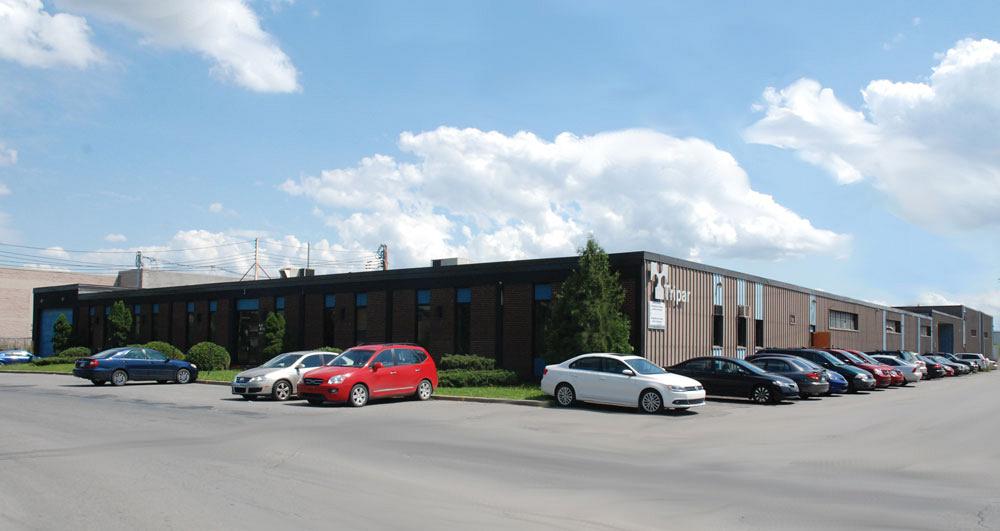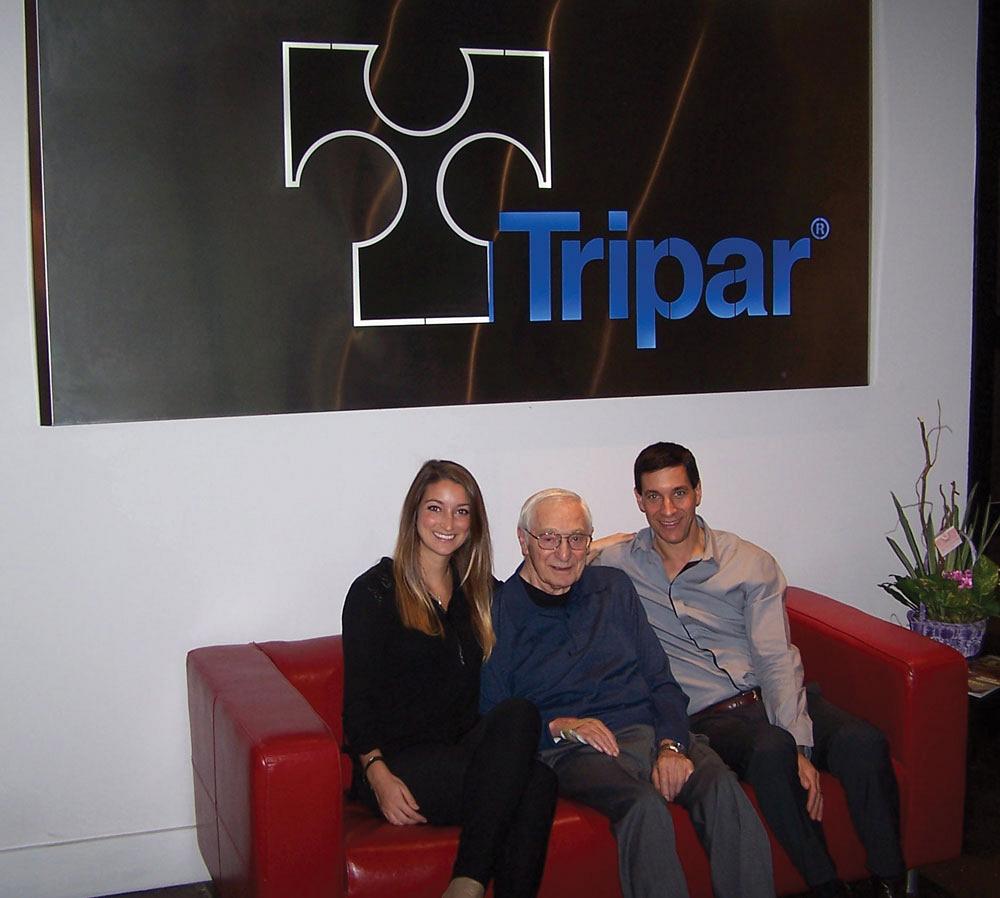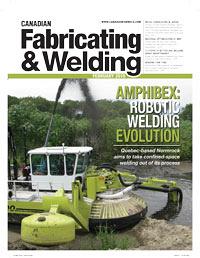Associate Editor
- FMA
- The Fabricator
- FABTECH
- Canadian Metalworking
Metal stamping shop marks 70 years in business
Montreal-based Tripar focuses on stamping quality components for the lighting industry.
- By Lindsay Luminoso
- February 28, 2019
- Article
- Fabricating

Tripar was founded in 1949 as a small job shop by brothers Ben and David Sevack, recent immigrants who chose to call Montreal home.
This year marks the 70th anniversary for Tripar, a Montreal-based metal stamping manufacturer. Tripar was founded in 1949 as a small job shop by two brothers, Ben and David Sevack, recent immigrants from England following the Second World War who, given the option of settling in New York or Montreal, chose the latter to call home. In its infancy, the shop took on any stamping and fabricating projects it could. It wasn’t until the early 1960s that the brothers found their sweet spot in the lighting sector.
Montreal was booming throughout the ‘70s, and Tripar took advantage of this by supplying surrounding companies with metal stampings, making many of the light fixtures and lamp parts for the region’s manufacturers.
"We were expanding our range of lighting parts for different companies, not just in Canada, but spreading out into the Greater Toronto Area, Upstate New York, and New England," said Andrew Gordon-Stewart, sales and marketing manager for Tripar. "We really focused on the northeast region."
In 2001 Tripar added another family member to the team when Ben’s son Lloyd, an engineer by trade, joined the company. Lloyd brought his savvy business acumen and was able to navigate the 2008 recession and pull the company through a time when domestic manufacturing became very challenging. Gordon-Stewart said that part of the reason Tripar was able to manage during the recession was that the company had very little debt, owning all its machines and building.
"We were able to keep all the key people employed," said Gordon-Stewart. "All of the technical knowledge and experience base that we had built up over the years remained within the company, especially in our engineering, toolroom, and maintenance departments."
Fast-forward to 2013. Lloyd, owner and now president, brought his daughter Lauren onboard, who is now director of human resources, so today Tripar has three generations of the Sevack family running the company.
Since its early beginnings, the company has transformed itself into a 65,000-sq.-ft., family-operated metal stamping and fabricating business with over 100 stamping presses and extensive metal fabricating equipment, manufacturing commercial and architectural lighting components, as well as components for a number of other industries, with an expanding reach across North America and Europe.
Stamping Business
It wasn’t until the mid-2000s that the company really found its niche in the commercial and architectural lighting segment.
"It has been tricky being a North American manufacturer, with higher operating and labour costs to compete in the entry-level lighting space," said Lloyd, now owner and president. "We realized in the entry-level market Asia was able to offer huge cuts in prices for large volumes. However, the mid- to high-price-range client was not so much focused on getting the lowest price as they expect additional features and design elements."
The company focused on meeting these design and engineering needs by keeping everything in-house. They’ve also changed their sales practices, offering blanket orders, often allowing customers to lock in a particular price for a large quantity, but receiving small shipments over a period of time.

Since its beginnings, the company has transformed itself into a 65,000-sq.-ft. family-operated metal stamping and fabricating business.
However, in the past year this practice has become somewhat of a challenge because of the tariffs on steel and aluminum. Though Tripar’s products are not subject to these tariffs, they have created considerable nervousness in the material markets; in some cases, material costs jumped upwards of 40 per cent.
"This is where it became a tough balancing act and we had to adapt," said Lloyd. "We used to be able to offer blanket orders in year segments, but with material prices fluctuating, it is hard to guarantee pricing over one year. So, we’ve had to get creative. We’ve had to shop around more between our suppliers, which has allowed us to keep our prices relatively low and very competitive."
Tripar works with a number of different materials, including galvanized, cold-rolled, and stainless steels and aluminum, in both sheet form and coils ranging from ½ in. to 20 in. wide. It also offers some parts in brass, copper, as well as prefinished materials.
When it comes to stamping prefinished (prepainted or preplated) parts, one thing that operators need to be aware of is the limitations of stretching. These materials often are not suited for drawing or deep drawing because the stretching will damage the finish. Such prefinished materials are ideal for shallow stamping (for example, wall plate covers) and parts with simple bends.
Drawing and deep drawing are two additional processes that allow Tripar to stand out in the market. They allow the stamper to produce larger bowl- and cylinder-shaped parts. For example, if you think of a suspended light fixture that has a long cylinder closed at the upper end and a light at the bottom end, that would be deep-drawn.
"In our experience, some customers are making such parts by the metal spinning process, and for low quantities, it’s cost-effective if done right," said Lloyd. "However, metal spinning usually is limited to round shapes, and it often requires a secondary operation to remove the spin marks. By contrast, square and other shapes can be produced by drawing and deep drawing, resulting in a finely finished part with tolerances unachievable through spinning. We produce many such parts, including a severely drawn metal cylinder measuring about 11 in. deep with a 5-in. diameter."
The company also offers progressive die stamping, the dies of which are all designed and produced in its in-house toolroom. Some of these are over 5 feet long, containing as many as 12 stations, with complete parts falling off at high production rates.
The company currently has over 1,600 dies and about 100 presses with a maximum capacity of 200 tons. With two shifts running six days a week, Tripar currently has approximately 65 employees, which is 20 more than one year ago. If the market warrants, it has the capacity and flexibility to ramp up production.
Hybrid Approach
Over the last five years, what Tripar makes and how it makes these parts have changed. Lloyd recognized that offering other services in addition to metal stamping could open new opportunities for the company to compete in markets that it previously had not ventured into. The company invested significant capital in new CNC fabrication equipment, including a fibre laser, several CNC press brakes, a CNC milling machine, a wire EDM machine, and most recently a new CNC punch/laser combination machine.
According to Gordon-Stewart, there are a lot of CNC fabrication shops in Montreal that make superb parts and many are working with large multinational companies, often in the aerospace market. Most of those companies focus solely on CNC fabrication, limited to flat development and simple sheet metal. Tripar has attempted to do something different, crediting the knowledge and expertise of its employees. The company has developed a hybrid approach to manufacturing, using CNC machines for lower quantities. However, for parts requiring special features, it can perform stamping as a secondary operation to drive down the cost.
With over 1,600 dies, the company has a number of blank dies and die sets to allow its toolroom to design and manufacture simple die inserts to offer variants of parts within the same die. For example, if a flat part needed both sides bent and an extruded hole added in the middle, other manufacturers may look to cut and punch the flat part using a CNC punch or laser, then bend the sides, followed by extruding the hole.
Instead, Tripar, because of its extensive die library and technical experience, can often incorporate multiple processes together, obtaining the flexibility and the customization afforded with its CNC equipment, combined with the economies of scale, quality, and speed of stamping.
"For our existing clients, especially in lighting, they’re loving it," said Gordon-Stewart. "It allows them to take advantage of a standard range of components and customize them to meet different projects."
This is a market trend that Tripar has found over the last five or six years. Before the early 2000s, customers would come up with a design and have to commit to it for three or more years to justify the design and manufacture of one or more metal stamping dies, each of which can easily cost into the tens of thousands of dollars (and beyond). However, product life cycles have shortened from years to months, and customers aren’t necessarily willing to invest in dies for a short-run production.
By adding CNC equipment, Tripar can tackle these jobs and build relationships. If and when a customer’s project quantity increases, Tripar can tell that customer at which point tooling can be justified, what the tooling cost will be, and what the resultant unit price will drop to. This information allows the customer to switch over to a die that would have a very short ROI.
"We’re finding it’s not only opening up brand-new opportunities in the lighting sector, but we’re getting new opportunities in many other industries," said Lloyd. "This combines to lower our capital investment risk, which is great, as sales are increasing every year. I’ve been speaking with many people in the industry and they would love to have such a mature company with solid growth over the last five years. It’s been double-digit annual growth for quite a few years now, which is brilliant."
Tripar has found its sweet spot but continues to expand to better serve its customers. By offering new and enhanced capabilities, it has broken into new market segments. The manufacturer continues to look for new ways to innovate its metal stamping and fabricating business while keeping with its roots.
"We are proudly Canadian," said Sevack. "We’re proudly a Montreal, Quebec, and North American company. We’ve built a business that reinvests within Canada and North America."
Associate Editor Lindsay Luminoso can be reached at lluminoso@canadianfabweld.com.
Tripar Inc., www.triparinc.com
About the Author

Lindsay Luminoso
1154 Warden Avenue
Toronto, M1R 0A1 Canada
Lindsay Luminoso, associate editor, contributes to both Canadian Metalworking and Canadian Fabricating & Welding. She worked as an associate editor/web editor, at Canadian Metalworking from 2014-2016 and was most recently an associate editor at Design Engineering.
Luminoso has a bachelor of arts from Carleton University, a bachelor of education from Ottawa University, and a graduate certificate in book, magazine, and digital publishing from Centennial College.
subscribe now


Keep up to date with the latest news, events, and technology for all things metal from our pair of monthly magazines written specifically for Canadian manufacturers!
Start Your Free Subscription- Trending Articles
Aluminum MIG welding wire upgraded with a proprietary and patented surface treatment technology

CWB Group launches full-cycle assessment and training program

Achieving success with mechanized plasma cutting

Hypertherm Associates partners with Rapyuta Robotics

Brushless copper tubing cutter adjusts to ODs up to 2-1/8 in.

- Industry Events
MME Winnipeg
- April 30, 2024
- Winnipeg, ON Canada
CTMA Economic Uncertainty: Helping You Navigate Windsor Seminar
- April 30, 2024
- Windsor, ON Canada
CTMA Economic Uncertainty: Helping You Navigate Kitchener Seminar
- May 2, 2024
- Kitchener, ON Canada
Automate 2024
- May 6 - 9, 2024
- Chicago, IL
ANCA Open House
- May 7 - 8, 2024
- Wixom, MI

















